1 day to go: SuperFooty looks back on some of the best No.1s to play the game
The No.1 carries an extra weight for those players who choose to carry the number on their back. But there’s been plenty of greats who have worn it and now you can decide who has been the best of them.
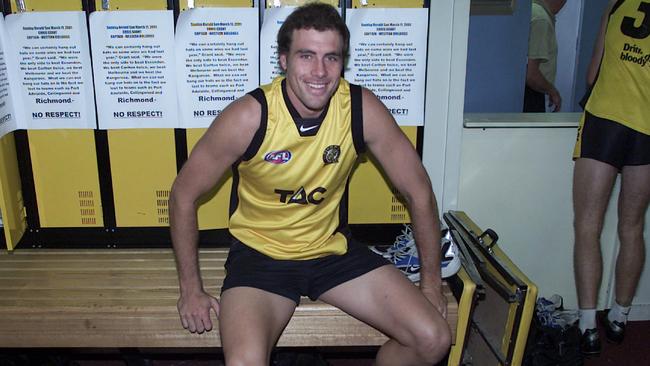
AFL
Don't miss out on the headlines from AFL. Followed categories will be added to My News.
Numero uno translates as “better, more important or more popular than anyone else”, and therein perhaps lies the reason why No.1 hasn’t adorned the backs of more AFL champions.
Put simply, players don’t always want the added pressure of carrying a number that in the sporting world suggests you are the best.
Unless you played for Collingwood between 1936 and 1978, when its club captain was expected to wear the number.
It ended when Ray Shaw, father of North Melbourne coach Rhyce and Greater Western Sydney player Heath, chose to stick with 23 when appointed captain by Tom Hafey in 1979.
That came after legends such as Harry Collier, Jack Regan, Lou Richards, Murray Weideman, Des Tuddenham, Wayne Richardson and Len Thompson had worn No.1.
The club that boasts the best No.1s is clearly Carlton (Horrie Clover, Fred “Pompey” Elliott, Frank Anderson, Billy Dick), helped enormously in 1959 when Sergio Silvagni swapped from 20 to No.1, which had had a year off after champion Ken Hands retired.
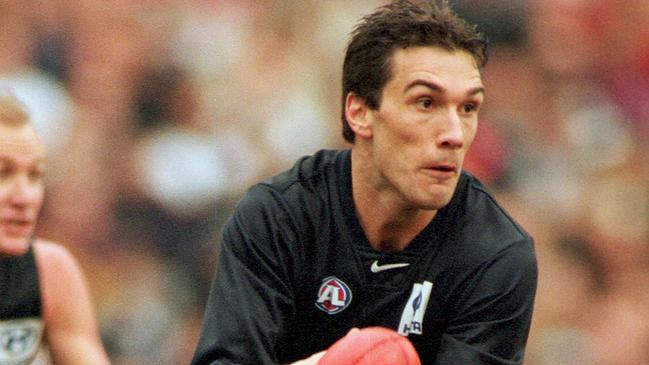
Sergio wore it in 227 games until 1971, when the number was given a rest before Jim Canfield, Dennis Collins and 1981 premiership centreman Greg Wells took it on.
Then the hope was Sergio’s son Stephen would be good enough to wear it at least once at VFL level.
He beat that wish by 311 matches before retiring in 2001, Andrew Walker then doing it justice from 2004 to 2016.
Grandfather Sergio and father Stephen proudly watch the number go around these days on Jack Silvagni.
Arguably the most popular No.1 was the long-sleeved version worn by St Kilda heart-throb Trevor Barker in 1977 to 1989. Barker inherited it from talented Tasmanian John Bonney, with Rodger Head having worn it in the club’s 1966 premiership side.
“I know some players didn’t want to wear it because it might put added pressure on them, but I only ever saw it as an honour to wear No.1 for the footy club I loved,” Barker said in 1991, five years before his death from cancer aged just 39.
“To see a young boy or girl in the crowd with your number on their back made me feel very proud.”
Relive classic AFL matches from the 60s to today on KAYO SPORTS. New to Kayo? Get your 14-day free trial & start streaming instantly >
WHY BOB UPGRADED TO NO.2
- Chris Cavanagh
Bob Murphy jokes that his skinny frame could not carry two numbers when he started his career.
In his debut season in 2000, the Western Bulldogs great played three AFL games wearing No.22 on his back.
“No.22 was a bit too heavy for me, so I had to get rid of one of the numbers,” Murphy said. “My frame couldn’t hold up two numbers.”
Murphy did not set the world on fire in those three games, but was promptly offered an upgrade to the No.2 for the 2001 season regardless.
He was not going to turn it down.
“To be honest, I would have been happy to play out my days in No.22,” Murphy said.
“I wouldn’t be so bold as to storm into the footy manager’s office and demand another number after three pretty average games of footy.
“But when you get given a number like that, you just take your locker and don’t cause too much trouble.”
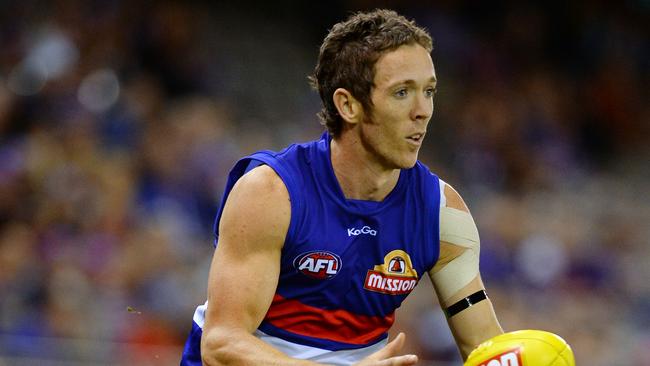
The No.2 was passed on by Steve Kolyniuk, who retired in 2000 after 177 games and 198 goals for the Bulldogs.
Bernie Quinlan — who won a Brownlow Medal with Fitzroy after starting his career with Footscray — was among other club greats to don the No.2 at Whitten Oval.
“It’s been worn by some incredible players — Bernie Quinlan and the great Jack Collins, who wore it in the 1954 Grand Final,” Murphy said.
“So when I think of the No.2, I think of it in terms of the Bulldogs’ locker room.
“But there’s also Jarryd Roughead, who’s one of my great mates, and Robbie Flower, who was a hero to me and he was the patron saint of skinny blokes playing league footy.”
Murphy, who played 312 games, said his fondest memory in No.2 was when he led the Bulldogs out as captain for the first time in Round 1, 2015.
Murphy captained the Bulldogs for three years from 2015-17 before retiring.
“I don’t know how many times I got to do it, but to lead the boys out the first time in No.2 was something pretty special,” Murphy said.
“I’ll never get blasé about that honour.”
NO.3 WAS JUST A NUMBER BACK THEN: LETHAL
- Chris Cavanagh
Leigh Matthews never cared much for the number on his back.
“At the time the No.3’s on your back you wouldn’t even know you’ve got it on until you watch yourself on the replay,” the ex-Hawks champion said.
“So I don’t think I really had a great affinity with No.3.”
Matthews did, however, request a lower number after starting his career in No.32.
He wore that number for his first three years at the Hawks, which included the 1971
premiership.
“No.3 became available when Peter Chilton retired, so I think I did ask for it,” Matthews said.
“I was just happy to go to a lower number for some reason.
“But I’d never worn the number before that.”
Matthews won another three premierships — in 1976, 1978 and 1983 — wearing the No.3.
He finished his decorated career as an eight-time Hawthorn best-and-fairest and six-time club leading goalkicker to be recognised as arguably the greatest player of all time.
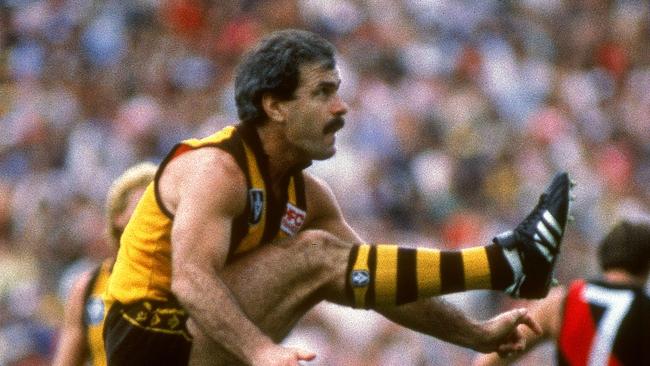
A forward pocket in the AFL Team of the Century and an inaugural Legend in the
Australian Football Hall of Fame, Matthews went on to be a four-time premiership coach at Collingwood and Brisbane Lions.
But one moment stands out from his playing career in No.3 – the 1983 Grand Final.
“My single fondest memory in the No.3 was probably when I was captain in 1983, and the
captain gets the honour of going and receiving the premiership cup,” Matthews said.
“That’s probably as good as it gets.”
Since Matthews, two-time premiership player Anthony Condon, fullback Jonathan Hay, four-time premiership star Jordan Lewis and Brownlow medallist Tom Mitchell have worn the No.3.
Matthews presented Mitchell with his jumper after his move from Sydney at the end of 2016.
“The players that have worn No.3 at Hawthorn thereafter, for some reason, you feel like you have a very slight connection with,” Matthews said.
SAM HAPPY TO BLAZE TRAIL FOR GREATS IN NO.4
- Jon Anderson
When 18-year-old “Slammin” Sam Kekovich stormed into Arden St Oval over the summer of ’68, he was ready to help a battling club point towards unheard of happiness.
North Melbourne knew it had snared something special in Kekovich. His hometown of Myrtleford fell into North’s recruiting zone which encompassed the rich playing fields of the Ovens and Murray Football League.
And right from the first practice game he combined a rare combination of extreme strength and natural skills, so a number befitting his talents had to be found. Enter No.4.
“With the greatest respect to Barry Allan, who was a loyal servant of our club and the previous occupant of four, such a prestigious number was in dire need of some refurbishment and it’s fair to say God had kindly blessed me with the essential tools to do so,” Kekovich, 70, said.
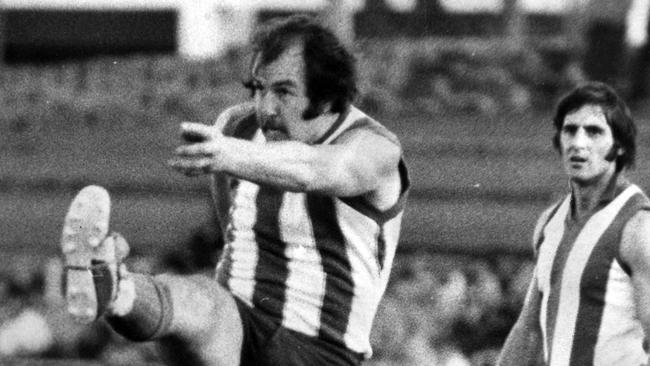
“To their eternal credit the club did its due diligence and quickly realised the number was about to scale rarefied air, having previously hovered around base camp for much of the 1960s.
“It remains a source of great pride that the number featured in our first premiership of 1975, even if prior commitments of a private nature didn’t allow me to take my place in the team photograph.
“Modesty naturally precludes me from going so far as to say I was a trailblazer for the number, although the evidence is overwhelming when you consider it has since been worn with great distinction by Ross Glendinning, Mick Martyn and Shaun Higgins.”
FAN’S LETTER URGED HIRD TO GIVE BACK NO.5
- Michael Warner
The letter was pinned to James Hird’s Windy Hill locker when he arrived for pre-season training on a Monday morning in February 1993.
Taken with pick 79 in the 1990 national draft, the scrawny kid from Canberra with a big mop of hair was slow to make an impression on the Essendon faithful.
“I wore 49 for my first four (senior) games in 1992 and was given Terry Daniher’s No.5 at the jumper presentation night in early 1993,” Hird recalled this week.
“When I got to my locker the next Monday morning there was a letter from a lady who spent about 35 lines telling me why I wasn’t worthy of wearing Terry Daniher’s number.
“She said he was the greatest player of all time and that I should do the right thing and hand it back and just keep 49.
“As a second year player I didn’t get a lot of mail. It was lovely.”
But while the supporter doubted Hird was worthy, master coach Kevin Sheedy knew better.
“Terry’s last game was the 1992 reserves premiership, which I played in with him,” Hird said.
“Sheeds was always keen on giving numbers to similar-type players. Steven Alessio got 27, which Simon Madden wore.
“Terry Daniher was my idol as a kid, I wore his number on my back for 15 years, so you can’t really believe it when you get the number of your childhood hero to wear on your own back.”
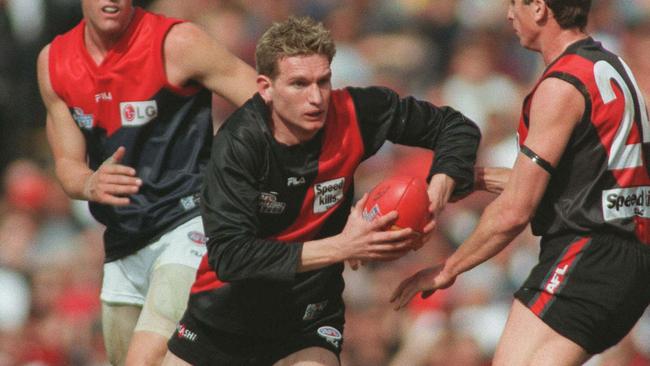
Did the lady get it wrong?
“Who knows? Probably she did, but I can understand it because Terry was this iconic dual premiership captain and I was a young kid who had played four games.
“It was a privilege to wear the number.
“Stants (Brent Stanton) took it after me and did a pretty good job in it and now Devon Smith has got it and he’s already won a best and fairest in it, so that’s a good sign.
“He’s a very good player.”
Eight months after receiving the lady’s letter, Hird played in Essendon’s “Baby Bombers” premiership team, adding a second flag seven years later as skipper of the 2000 Invincibles.
Hird won a Brownlow Medal in 1996, was a five-time All-Australian, a five-time best and fairest winner, won three Anzac medals, a Norm Smith Medal and two club goal kicking awards.
But in a field that features Gary Ablett Sr, Nathan Buckley, Polly Farmer, Chris Judd and Sam Mitchell, the No.5 guernsey might just be the most esteemed of them all.
IS JOHNNO THE BEST NO.6 EVER?
- Scott Gullan
Brad Johnson had been a diehard Western Bulldogs fan who grew up just down the road from the Whitten Oval, so he was well and truly across the history of player numbers.
When his childhood dream was realised and the Dogs took him at No.11 in the 1993 national draft, he allowed his mind to wonder about what jumper he might be allocated.
Johnson had worn No.6 in his last year at the Western Jets, but when he got offered No.33 at the Bulldogs it was a win on a number of fronts.
Rover Brian Royal had worn No.33 for the previous decade and became a much-loved player throughout his 199 games, which included winning the club’s best-and-fairest award in his first season. And the numerology also worked.
“When I walked into the club I was offered 33 as Brian Royal had just retired so that was a real positive to have his jumper,” Johnson explains.
“I had worn No.6 the year before at the Western Jets, and that was probably my best year of junior footy, so I thought with 33, the two threes, three plus three is six, so I was also pretty happy about that.”
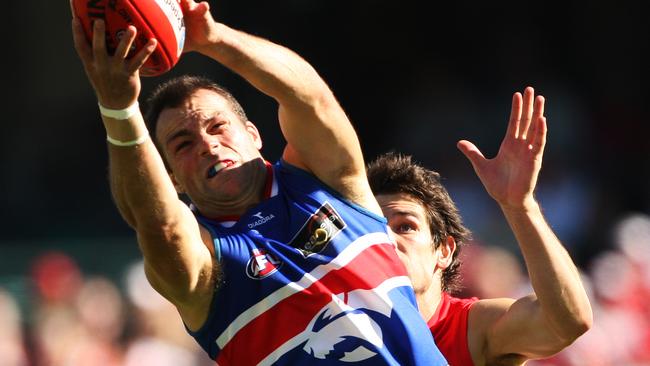
Johnson made his debut five days after his 18th birthday in Round 18 against Collingwood and played nine games for the season.
Bulldogs officials soon realised they had a pretty special player in their ranks and over the summer they approached Johnson about a number change.
The No.6 had a level of reverence about it at the Whitten Oval because two of the club’s legends had worn the jumper — 1954 premiership captain/coach Charlie Sutton and 1969 Brownlow Medal runner-up George Bisset.
“For us it was always known as Charlie’s number because he was the first captain/coach to win a flag and then Georgie Bisset wore it, and we all knew how good he was as well,” Johnson says.
“That history was explained and it really was all around Charlie Sutton. So when I was called in and offered it, in the back of my mind I was jumping at it for other reasons as well.
“In my mind it was also my lucky number.”
It was certainly a lucky charm for Johnson who went on to become one of the greatest players in the game, wearing the No.6 with distinction for an AFL record 355 games.
He went on to captain the club and won the club’s best and fairest award, which was named after Charlie Sutton, three times.
Carlton veteran Kade Simpson is closing in on Johnson’s record with 326 games in the No.6, while Brisbane Lions premiership star Luke Power is next on the all-time list on 302 games.
WHY HAWKINS TURNED DOWN ‘LUCKY’ NO.7 AT FITZROY
– Scott Gullan
It’s one of his go-to lines at sportsman’s nights or pub trivia events and, according to Doug Hawkins, he’s batting a thousand.
The Western Bulldogs legend holds the AFL games record for the No. 7 jumper, wearing it 329 times from 1978 through to 1994.
That’s a fact most football fans would be across but where they come unstuck is when he asks them about what number he started in.
“When I do my sportsman’s nights or trivia, I say, ‘Is it true I wore No. 7 straight away at the age of 17?’,” Hawkins says.
“Everyone says no way, there’s no way you would get that sort of number. But I actually did.
“Normally a 17-year-old doesn’t get seven, they normally get 58 or 68.”
Hawkins had worn No. 7 the previous season at Braybrook and couldn’t believe it when he arrived at the Bulldogs to find his lucky number was available.
“In 1977 it was worn by Ray Huppatz but he left the Bulldogs and went to North Melbourne,” he said.
“Robert Groenewegen, he was also from Braybrook and we went down together. He ended up getting 14, which Barry Round had worn before leaving a couple of years earlier, so we were both pretty lucky.”
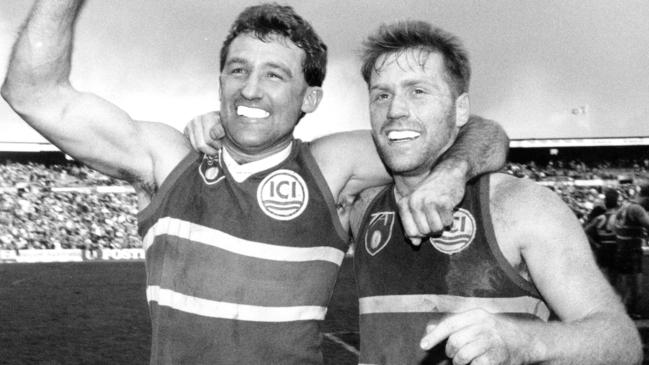

When Hawkins controversially moved to Fitzroy for his final season in 1995, the No. 7 was passed on to good hands with Scott West shifting down from 14.
West played 284 games in the jumper to come in ranked fourth on the all-time list behind St Kilda star Lenny Hayes at No. 2 (297 games) with Essendon’s two-time Brownlow Medallist Bill Hutchison third (290).
Hawkins was offered No. 7 at Fitzroy but turned it down because he wanted to honour his good friend and Footscray legend Ted Whitten.
Young gun Jarrad Molloy had worn the jumper the previous season and approached his new teammate about a swap.
“I said. ‘Mate, you’ll be here longer than me’,” Hawkins said. “I was thinking I would only have one or two years but at that stage I didn’t know the club was in serious trouble.
“But No. 3 was free and I knew EJ was crook so I said to Bernie Quinlan, who was the coach, ‘I’ll wear No. 3 for EJ’.
“So that’s the reason I wore No. 3 at Fitzroy, to honour Teddy who then obviously passed away that year.”
No. 8: IS THIS FOOTY’S ULIMATE CULT HERO?
– Jon Anderson
Never has so much noise been made for someone who played so few games.
Jack Mihocek, these days the proud father of Collingwood’s Brody, may have played just 13 matches for Essendon between 1976-78, yet he remains a cult figure to this day.
The Windy Hill crowd would regularly work itself into a fever pitch when the nuggety redhead from Essendon Districts burst onto the ground in the number 8 which had earlier been worn in the 1970s by Essendon captain-coach Des Tuddenham.
Most of his 13 games saw Mihocek begin the game on the bench, just as another red-headed substitute named David Fairclough was successfully doing for Liverpool in European soccer at the same period.
“Des Tuddenham was my hero so to wear his jumper meant so much. ‘Tuddy’ took an interest in me when I was in the U19s then he went back to Collingwood and they gave me his jumper,” said Mihocek who runs a sports store in Burnie.
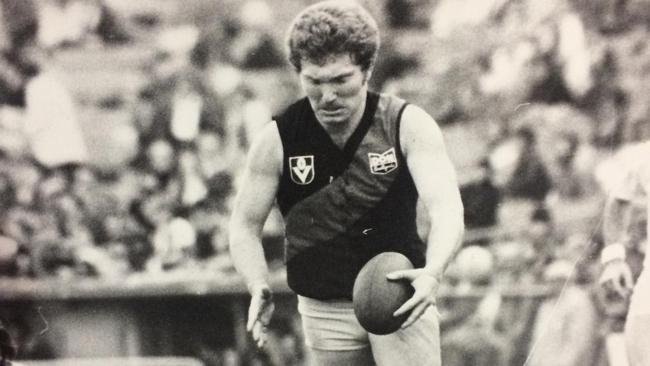
“I tried to be a tough macho man, had the red hair and for whatever reason the fans loved me. The crowd used to scream, ‘Get Jack on’ so being young and stupid, I would tear around like a headless chook.”
He was gone from the then VFL by 21 and began a footballing journey that took Mihocek to Tasmanian clubs Scottsdale and Cooee, then Frankston, Deer Park, Echuca, Hampton Park and even a game of senior soccer with Footscray … JUST.
Clearly he is well down in the ranks of great number 8s when compared with icons such as Richmond trio Jack Riewoldt, Dick Clay and Michael Roach, but can any of them claim to have had a song written about them?
That came about in 2003 when Mihocek was the inspiration for a single by Dave Warner titled “Where Is Jackie Mihocek?”. Warner explains why.
“I know Jack Mihocek only played a few games but if you were a Martian and just arrived in Melbourne, you’d think this guy was the greatest player of all time who had a profound effect on people’s lives despite just the tiniest exposure,” said Warner.
The song includes lyrics that shout “I was an uncommitted fan, Until one day I saw that man, dashing fast and splitting packs, Where is Jackie Mihocek?”.
While Bomber fans still fondly recall Mihocek’s cameo appearances, Richmond supporters have been blessed to see number 8 worn by club champions in Clay, Roach and Riewoldt, plus one of their early superstars in wingmen Allan Geddes from the 1930s.
When Roach first started with Richmond in 1977, the Tigers knew they had a young gun and had the number 8 set aside for him following Dick Clay’s retirement. But out of courtesy they asked Roach what number he would like.
Roach had worn 10 in his junior days in Tasmania and asked if it might be available, before being told they didn’t think Kevin Sheedy would want to part with it.
NEITZ’S AFFINITY WITH THE NO. 9
– Lauren Wood
David Neitz was pretty wet behind the ears when his affinity with the Demons’ No. 9 began.
Aged “about 15”, the teenager from Keysborough was invited to the Melbourne Cricket Club by the famous red and blue in an effort to keep hold of the young forward who lived in their recruiting zone in Melbourne’s southeast.
And it was through pure coincidence that the player tasked with hosting him that day happened to wear the number he would go on to wear in his career that remains the longest of any other Demon.
“My very first experience with the Melbourne footy club, I was about 15 and they invited me to go and watch a Melbourne game,” Neitz recalled this week.
“I was a young kid in their (recruiting) zone, so they invited me in to the MCC, and for a young kid from Keysborough it was all very exciting, with the family.
Relive classic AFL matches from the 60s to today on KAYO SPORTS. New to Kayo? Get your 14-day free trial & start streaming instantly >

“And Alan Johnson — who was injured that day — was sitting on our table. He took me under his wing, took me into the changerooms and introduced me to the guys and gave me this amazing experience of the Melbourne footy club.
“He wore No. 9, so my first experience was there with him and it just ended up being the number I ended up wearing for a whole stack of games.
“It was a great coincidence and it’s a great bit of history that I share with Alan whenever we catch up.”
But it hadn’t been Neitz’s first choice.
He wore the No. 38 guernsey in his first season at the club in 1993, playing 20 games that year before a few highly-sought lower numbers opened up.
“Both the nine and the 10 were available … and I was actually quite keen on the No. 10 at the time,” Neitz laughed.
“But Shane Burgmann took that. We were good mates … his dad (Lloyd) played for the club, so there was a bit of a history with the 10, so I sat next to him and took the No. 9.”
Burgmann played just one game, 305 shy of Neitz’s final tally over the next 15 years.
Like many AFL players, the number sat alongside Neitz’s autograph throughout his tenure — which included eight years as skipper — “in case you couldn’t read the squiggle”, and he admits he remains strongly attached to the number.
“I think I forever will be,” he said.
“I try to include it wherever I can. Invariably there’ll be a nine in my passwords and things, somewhere along the line. The number nine keeps on cropping up, that’s for sure.
“And it’s good to see the young kids coming through with the No. 9 for the Demons, as well.”
GREAT TIPS CURRENT STAR TO BREAK HIS NO. 10 RECORD
– Lauren Wood
It was a stat that the man himself wasn’t even aware of.
Marcus Ashcroft is the longest-serving No. 10 player in history, having snapped up the opportunity for a lower number in his second year at the Brisbane Bears in 1990.
After – ironically – 10 games in No. 43 in his first season, Ashcroft inherited the guernsey upon the departure of John Fidge at the end of 1989 and played another 308 games.
“I didn’t even know that until you told me … no doubt (it’s special to hold the record),” Ashcroft said this week.
“When you can hang around for that long and be able to do that in a really tough game, that’s a really special thing to be able to do.
“And I guess it stays there for as long as until the next person comes along and get more games. I’ve got great memories over my time in the AFL, and that’s just another one you reflect on and say ‘that’s another great thing to look at’.”

But he might not hold the mantle for long, with Collingwood star Scott Pendlebury nipping at his heels with 293 games in the 10.
“He’ll get there for sure … absolutely for sure,” Ashcroft laughed.
The three-time premiership player – who saluted as part of the Lions’ dominant three-peat in 2001, 2002 and 2003 before calling time on his 318-game career – spent eight years as football manager at Gold Coast and is now a talent manager with the AFL, albeit currently stood down amid coronavirus.
He recalled that he had merely “fell into” the number, with no special presentation or the like, but said that he still felt a strong connection to the number, with a No. 10 jumper just happening to fit his son Will at last year’s national championships.
Ashcroft presented Lions ballwinner Daniel Rich – who is the Lions’ longest-serving No. 10 behind Ashcroft – with the guernsey in 2009 in what he said was an element of the current game that clubs “do really, really well now”.
“It was in 1990 when I got the number, in my first year they did a jumper presentation to play your first senior game, but with social media and the way it is now, they do a bigger deal of it in today’s footy,” he said.
“I was lucky enough to present Daniel Rich with No. 10 when he made his debut. Being a proud Queenslander and having grown up on the Gold Coast and playing with the Bears and Lions, for me to play in No. 10 for such a long time, that’s a special thing, but to be able to pass it on to someone like Daniel who’s doing great things with it now is also nice.
“Now that I’ve got kids that are aspiring AFL players, hopefully if they’re good enough, you just never know (where it might end up). All that stuff’s really special to me, being based in Queensland my whole life really.”
MORE AFL
KFC SuperCoach rookie bible: Every cheapie rated ahead of Round 2 price changes
Carlton to display a member’s name on the back of its jumper for three matches this season
HOW DIESEL STOLE ABLETT’S FIRST CHOICE NUMBER AT CATS
– Jon Anderson
He may have lacked the poise of Bruce Doull or the reckless abandon of Glenn Archer, but Geoff Blethyn’s story is even more remarkable than his illustrious fellow wearers of the No. 11 jumper.
Looking like an Australian version of US musical genius Buddy Holly, bespectacled Blethyn remains the most unlikely of the 21 living men to have kicked 100 goals in a VFL/AFL season.
Everything about Blethyn broke the mould, from his third game when he kicked four goals for Essendon as a 17-year-old in its three-point loss to Carlton in the 1968 VFL Grand Final, to his 183cm and 78kg frame that was so removed from the physical stereotype for his position of full-forward.
Relive classic AFL matches from the 60s to today on KAYO SPORTS. New to Kayo? Get your 14-day free trial & start streaming instantly >

Typically, when he kicked 107 goals from 23 games in 1972 it came from nowhere. Blethyn had booted just 70 goals in his previous 47 games from 1968-71.
And then, having joined the likes of Peter Hudson, Peter McKenna, Doug Wade and Alex Jesaulenko (who had all notched tons in the same period) Blethyn walked away from the VFL aged just 21.
“I was offered a job in Perth as a state manager of a textile firm and that season had seen Peter Hudson go down with a knee injury,” Blethyn said. “You don’t get handed jobs as a state manager at age 21 too often so I thought, why not?”
He played three seasons with WAFL club Claremont, and kicked 73 goals in 1973, before he returned to Essendon in 1976 for one season.
He injured his knee late in the year as he delivered 39 goals from 14 matches.
“From a footy career I wouldn’t say it was the right decision to leave at the end of 1972, but from a life choice it was,” Blethyn said.
“Do I have regrets? It would have been interesting to see how I went had I stayed in Melbourne, but I’m proud to be one of 28 players to have kicked 100 goals in a season.”
The most famous player to wear No. 11 in Australian rules never actually donned it in an AFL or VFL match.
Gary Ablett Sr first wore 11 during his country days playing for the Drouin Hawks, including their victory over Cora Lynn in the 1979 West Gippsland grand final.
“When I went to Geelong in 1984 I actually wanted number 11 but they gave it to another new boy called Greg Williams,” Ablett said.
“I had played well in the practice matches and that’s when they decided to give me the number five worn by ‘Polly” Farmer.”
But Ablett was given number 11 on July 17, 1984, when he was selected to play for Victoria against Western Australia at Subiaco Oval. He booted eight goals from a forward-flank in a stunning display despite having played just nine games for Geelong.
“Allan Jeans (Victorian coach) didn’t want me in but Teddy Whitten guaranteed me, and if it wasn’t for him I wouldn’t have been in,” Ablett said.
“I was still struggling for confidence and it was a huge thing to go over to Perth with blokes I didn’t know. It was a transforming moment that changed my life. I went from an unknown to, ‘Who is this bloke?’
“All of a sudden people knew my name. I kicked eight but couldn’t win the medal (Simpson) for best (Brad Hardie won it for the winning WA side).”
STORY BEHIND RICHO’S MELBOURNE CUP OMEN BET
– Lauren Wood
It was on the back of a flat-tray truck in the middle of Punt Road Oval in darkness that Matthew Richardson officially received his No. 12 Richmond jumper.
It had always been a hope.
Richardson grew up in Devonport, the son of Alan “Bull” Richardson who wore the jumper for a decade as a Tiger, including in the club’s 1967 premiership.
“I always had the 12 on my Richmond jumper growing up as a kid,” Richardson recalled.
There were stints in higher numbers as he worked through the ranks at Devonport but it was pure luck that saw his treasured number free when he arrived at Richmond for the 1993 season.
“I was just lucky when I got to Richmond that Andrew Underwood who had the No. 12 before me had finished up the year before, so the 12 was free and with my dad having worn it in a premiership, they offered it to me, and obviously I was happy to take it,” he said.

“Bull” made the trip over from the Apple Isle to present it to his then-18-year-old son on Richmond’s hallowed turf.
“They had a jumper presentation night, an open training session and it was like a Thursday night before the Round 1 game,” Richardson, who went on to play 282 games, recalled this week.
“They had a flat tray truck out on Punt Road Oval and a few supporters came down to training. It was dark (by the time they did it), because it was after training and you had to train at 5 o’clock then because everyone had a full-time job.
“I remember my Dad actually flew over and presented me with my jumper on the truck on Punt Road Oval. It was really special.”
Richardson — who now commentates footy with Channel 7 — played for Richmond over the next 16 years, booting 800 goals and earning All-Australian selection three times.
He is now a member of the Australian football Hall of Fame, with “Richo” a hero of the Tigers faithful.
His father “Bull” passed away in 2015, but some traditions live on.
The No. 12 is honoured on Melbourne Cup day, too.
Richardson is not much of a punter, but come the first Tuesday in every November, he and his mum Diane have a flutter in honour of his dad.

“I’m not a punting person, I don’t bet that often on sport,” Richardson said.
“But at Melbourne Cup time … Dad used to always put $5 on No. 12, so mum does it now, now that dad’s not with us, and every Melbourne Cup we always have a bet on No. 12 to honour Dad and it’s something that he always did.
“I don’t think we’ve ever done much good, but we keep the tradition going.”
MORE AFL
AFL close to finalising plan for fans to attend matches this year
Sacked podcast preview: Travis Cloke reveals sledge that almost ended his career
AFL rejects push for an expanded six-man interchange bench in 2020
Originally published as 1 day to go: SuperFooty looks back on some of the best No.1s to play the game


